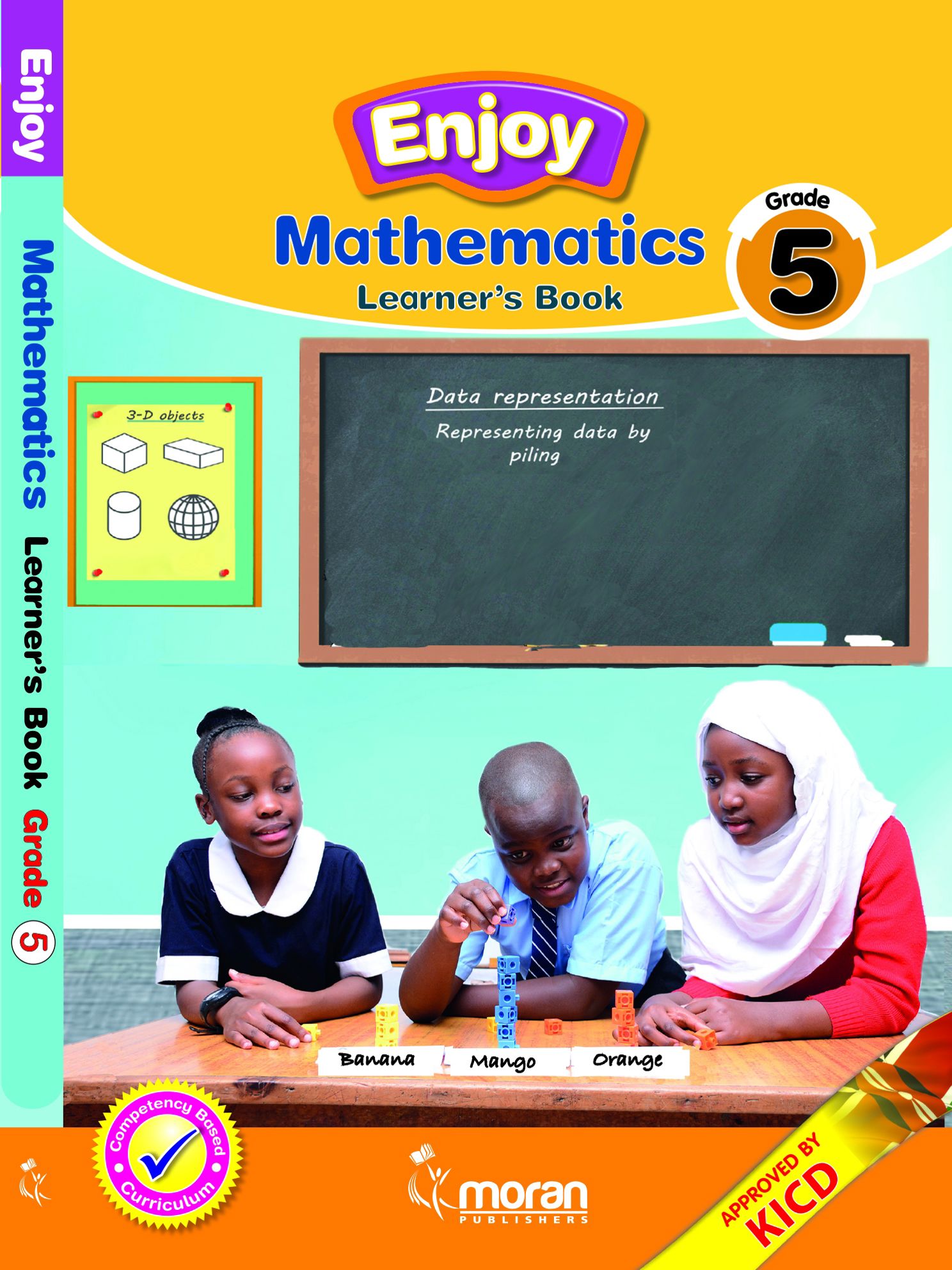
Authors
Paul Njoga, Geoffrey Gichuki, Nickson Oshome, Maina KiraguExercises kit’s authors
Paul Njoga, Geoffrey Gichuki, Nickson Oshome, Maina KiraguPublisher
Moran Publishers
Included in packages

-
The study kit contains 108 chapters and 641 exercises of which 534 are in the chapters and 107 in the task exercises.
-
Authors
Paul Njoga, Geoffrey Gichuki, Nickson Oshome, Maina Kiragu -
Exercises kit’s authors
Paul Njoga, Geoffrey Gichuki, Nickson Oshome, Maina Kiragu -
Subject
Mathematics -
Grade
Grade 5 -
Kit's language
English -
Publisher
Moran Publishers -
Included in packages
1. Numbers – Whole numbers
Lead |
Chapter |
|---|---|
| 1.1. |
Place value
Free chapter! |
| 1.2. | Total value |
| 1.3. | Writing numbers in symbols |
| 1.4. | Reading and writing numbers in words |
| 1.5. | Reading and writing numbers in symbols |
| 1.6. | Arranging numbers |
| 1.7. | Rounding off numbers |
| 1.8. | Divisibility by 2 and 5 |
| 1.9. | Divisibility by 10 |
| 1.10. | Factors and highest common factor |
| 1.11. | Divisors and common divisors |
| 1.12. | Greatest common divisor (GCD) |
| 1.13. | Multiples and common multiples |
| 1.14. | Least common multiple (LCM) |
2. Numbers – Addition
3. Numbers – Subtraction
4. Numbers – Multiplication
5. Numbers – Division
Lead |
Chapter |
|---|---|
| 5.1. | Division of 2‑digit numbers |
| 5.2. | Division of a 3‑digit number |
| 5.3. | Relationship between multiplication and division |
| 5.4. | Estimating quotients |
| 5.5. | Combined operations |
6. Numbers – Fractions
Lead |
Chapter |
|---|---|
| 6.1. | Equivalent fractions |
| 6.2. | Simplifying fractions |
| 6.3. | Comparing fractions |
| 6.4. | Ordering fractions |
| 6.5. | Adding fractions with the same denominators |
| 6.6. | Subtracting fractions with the same denominators |
| 6.7. | Adding fractions with renaming |
| 6.8. | Subtracting fractions with renaming |
7. Numbers – Decimals
8. Measurement – Length
Lead |
Chapter |
|---|---|
| 8.1. | Kilometre |
| 8.2. | Estimating and measuring distance |
| 8.3. | Converting kilometres to metres and vice versa |
| 8.4. | Addition without regrouping |
| 8.5. | Addition with regrouping |
| 8.6. | Subtraction without regrouping |
| 8.7. | Subtraction with regrouping |
| 8.8. | Multiplication without regrouping |
| 8.9. | Multiplication with regrouping |
| 8.10. | Division |
9. Measurement – Area
Lead |
Chapter |
|---|---|
| 9.1. | Square centimetre and area of a rectangle |
| 9.2. | Area of a square |
10. Measurement – Volume
Lead |
Chapter |
|---|---|
| 10.1. | Cubic centimetre and volume of a cube |
| 10.2. | Volume of a cuboid |
| 10.3. | Deriving formula for the volume |
11. Measurement – Capacity
Lead |
Chapter |
|---|---|
| 11.1. | Measuring capacity |
| 11.2. | Estimating and measuring capacity |
| 11.3. | Converting litres to millilitres and vice versa |
| 11.4. | Addition without regrouping |
| 11.5. | Addition with regrouping |
| 11.6. | Subtraction without regrouping |
| 11.7. | Subtraction with regrouping |
| 11.8. | Multiplication |
| 11.9. | Division |
12. Measurement – Mass
Lead |
Chapter |
|---|---|
| 12.1. | Measuring mass |
| 12.2. | Estimating and measuring mass |
| 12.3. | Converting kilograms to grams and vice versa |
| 12.4. | Addition without regrouping |
| 12.5. | Addition with regrouping |
| 12.6. | Subtraction without regrouping |
| 12.7. | Subtraction with regrouping |
| 12.8. | Multiplication |
| 12.9. | Division |
13. Measurement – Time
Lead |
Chapter |
|---|---|
| 13.1. | Second and minute |
| 13.2. | Converting minutes to seconds and vice versa |
| 13.3. | Addition |
| 13.4. | Subtraction |
| 13.5. | Multiplication |
| 13.6. | Division |
14. Measurement – Money
Lead |
Chapter |
|---|---|
| 14.1. | Budget |
| 14.2. | Tax |
| 14.3. | Bank |
| 14.4. | Saving |
15. Geometry – Lines
Lead |
Chapter |
|---|---|
| 15.1. | Horizontal and vertical lines |
| 15.2. | Perpendicular lines |
| 15.3. | Parallel lines |
16. Geometry – Angles
Lead |
Chapter |
|---|---|
| 16.1. | Relating a turn to angles |
| 16.2. | Use of angles |
| 16.3. | Unit angle and degree |
| 16.4. | Measuring angles |
17. Geometry – 3D Objects
Lead |
Chapter |
|---|---|
| 17.1. | 3D objects |
| 17.2. | 2D shapes in 3D figures |
18. Data Handling – Data representation
Lead |
Chapter |
|---|---|
| 18.1. | Data collection and representation in tables |
| 18.2. | Data representation and interpretation through piling |
19. Algebra – Simple equations
Lead |
Chapter |
|---|---|
| 19.1. | Forming simple equations |
| 19.2. | Solving simple equations |
| 19.3. | Forming and solving simple equations |
